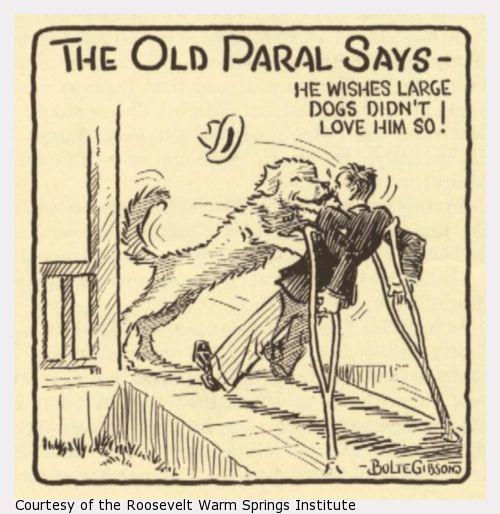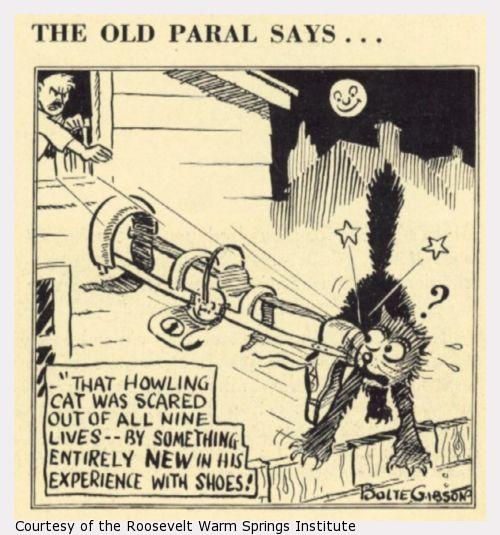"Polio Between the Ears" Cartoons of the Polio Chronicle
- Daisy Holder

- Feb 25, 2020
- 3 min read
Updated: Feb 11, 2022
This post has been a long time coming (it's actually not even technically the one you're waiting for, it's an interim one) but what do you want from me, I've been busy with the government sending me loads of letters asking me to do ridiculous things.

I came across this picture last week while just browsing for disability history images. I put it onto Instagram (by all means follow the links above to follow me if you don't already) but it's such a great cartoon I figured I'd look into the backstory.
Seriously, I don't need as much as a big dog. A small rabbit or a stiff breeze could do the same.
I found a whole selection of cartoons, six from "The Old Paral" series by Bolte Gibson and six from the "Polio Pete" series, all from the Disability History Museum (which is a great website which I will link to in my sources).

All these cartoons were originally published in the Polio Chronicle, made originally by and for the community living at Roosevelt Warm Springs Institute for Rehabilitation.
Polio Pete was drawn by G. Salmon Jr, and featured a lot of ideas for alternative uses for crutches, which I could do with since I now have SO MANY and could always use a beer holder and pretzel rack (see left).
The Polio Chronicle was started in 1931 as an 8 page newsletter for the residents of Warm Springs, but was passed around freely, and soon enough a large number of readers were doctors, nurses, physiotherapists and similar. They did sometimes choose their content focusing on this medical group rather than patients and residents, a course of action that got people calling them boring, and saying that "the CHRONICLE is too dry, that it lacks the proportion of humorous and light material to make it interesting to all!"
The "polios", as they called themselves, had a sense of humour that was considered quite shocking to many, not meek and charming, but angry and sarcastic, just like most of us are now! Roosevelt himself used to tell the story of a boy, sick of the able bodied people who were staring at him, turning around and snapped "stick around! They’re going to feed us after awhile."

This tone was reflected in Gilbert's "Old Paral" series (paral referring to a person who is paralysed to some degree.)
I tried to research Gilbert himself, but was a very hard person to track down. He was from New Jersey, ended up working as a cartoonist for the Camden Courier Post and got together with a local Reverend to sell a book of cartoons about church life to raise money for refurbishments, but I have not been able to confirm whether he had polio or was just polio-adjacent which is so incredibly annoying I may end up emailing the church itself to check.
The Institute itself was unusual. It was set up by Roosevelt as someone who had become disabled via polio himself, but it had a very different attitude to both other institutions and Roosevelt himself. The Chronicle would talk about themselves and former residents as "undergraduates" and "alumni", to bring a sense of community and identity and compel them to pay for a subscription to the magazine to aid their joint "crusade".
Unlike most other disability or illness groups of the day, this was a campaign run by and for disabled adults. They were raising money for patients of the disease sure, but most of their work was raising awareness and campaigning for a vast variety of causes, such as discriminaton, employment and medical care.

The residents of Warm Springs saw themselves as pioneers, and certainly were in the days before the traditional disabled civil rights movement. The focus was not on the cure to their ailment, like most of the treatment before had attempted, but to work alongside their disability.
The aims of the magazines to start writing more about "the humorous side of polio" was in part to raise spirits amongst the residents themselves, and also to show the non-disabled people reading that they shouldn't pity them (or risk having a leg brace thrown at them, as on the left)
"Interesting events are part of the Crusade, for they show how we here compensate for losses of athletics, etc. The funny incidents and accidents are a part of our attitude toward polio."
Eventually the Polio Chronicle was taken over by The Crutch (which sounds like me as a supervillain) which took itself even less seriously than the Chronicle including sections for children and gossip columns, which is something I absolutely want to read if anyone has a copy.
Sources:
- The Disability History Museum https://www.disabilitymuseum.org/dhm/index.html
- POLIO CHRONICLES: WARM SPRINGS AND DISABILITY POLITICS IN THE 1930s- Naomi Rogers, Yale University, 2009
- "Heads, You Win": Newsletters and Magazines of the Polio Nation- Jacqueline Foertsch, Disability Studies Quarterly, 2007





Comments